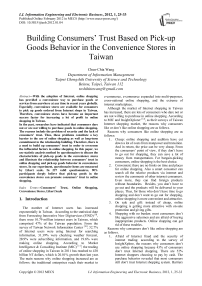Building Consumers' Trust Based on Pick-up Goods Behavior in the Convenience Stores in Taiwan
Автор: Chun-Chia Wang
Журнал: International Journal of Information Engineering and Electronic Business(IJIEEB) @ijieeb
Статья в выпуске: 1 vol.4, 2012 года.
Бесплатный доступ
With the adoption of Internet, online shopping has provided a convenience way to purchase goods or services from anywhere at any time in recent years globally. Especially, convenience stores are available for consumers to pick up goods ordered from Internet shops in Taiwan. Therefore, convenience stores have become an important success factor for increasing a lot of profit in online shopping in Taiwan. In the past, researches have indicated that consumers dare not or are not willing to purchase goods in online shopping. The reasons include the problem of security and the lack of consumers’ trust. Thus, these problems constitute a key barrier to the use of online shopping as well as long-term commitment to the relationship building. Therefore, there is a need to build up consumers’ trust in order to overcome the influential factors in online shopping. In this paper, we use statistic analysis method by questionnaires to discuss the characteristics of pick-up goods in the convenience stores and illustrate the relationship between consumers’ trust in online shopping and pick-up goods behavior in convenience stores. In our experiment, questionnaire items are measured by Likert scale. In 227 valid questionnaires, 90% participants deeply believe that pick-up goods in the convenience stores can promote consumers’ trust in online shopping.
Consumers' Trust, Online Shopping, Convenience Stores, Likert Scale
Короткий адрес: https://sciup.org/15013104
IDR: 15013104
Список литературы Building Consumers' Trust Based on Pick-up Goods Behavior in the Convenience Stores in Taiwan
- Bakos J. Y., “Reducing Buyer Search Costs: Implications for Electronic Marketplaces,” Management Science, 1997, 43(12), pp. 1676-1692.
- Bhatnagar A. and Ghose S., "A Latent Class Segmentation Analysis of E-Shoppers," Journal of Business Research, 2002, 57, pp. 758-767.
- Draxler G., Sametinger J., Wiesauer A., “Electronic Payment and Online Gaming,” Proceedings of the 16th International Conference on Distributed Multimedia Systems, October 14-16, Oak Brook, USA, 2010.
- Feng, C.M. and Huang Y.K., “The Effects of Switching Costs and Service Quality on Choice Behavior of the Pick-up Point for Online Shopping,” Transportation Planning Journal Quarterly, 2006, 35(4), pp. 507-542.
- Lee, K.O. and Turban, E., “A Trust Model for Consumer Internet Shopping,” International Journal of Electronic Commerce, 2001, 6(1), pp. 75-91.
- Sonja Grabner-Kraeuter, “The Role of Consumers’ Trust in Online-Shopping,” Journal of Business Ethics, 2002, 39(1/2), pp. 43-50.
- Visser E-J. and Lanzendorf M., “Mobility and Accessibility of B2C E-Commerce: A Literature Review,” Tijdschrift voor Economische en Sociale Geografie, 2004, 95(2), pp. 189-205.
- Wu Chao-Le, “The Study of Consumers' Preference in Receiving Physical Goods on Internet shopping,” Master Thesis, Tunghai University, Taichung, Taiwan, 2001.
- Internet in Taiwan 2010, FIND (Foreseeing Innovative New Digiservices): http://www.find.org.tw/find/home.aspx?page=many&id=282
- Taiwan Network Information Center 2010 (TWNIC): http://statistics.twnic.net.tw/item04.htm
- Market Intelligence & Consulting Institute (MIC) 2010: http://mic.iii.org.tw/aisp/pressroom/press01_pop.asp?sno=225&type1=2
- InsightXplorer 2011: http://news.ixresearch.com/?p=921


